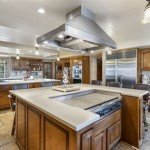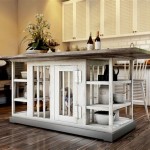What Material Is Best For Your Kitchen Sink? A Comprehensive Guide
The selection of a kitchen sink is a crucial decision in any kitchen design or renovation project. A sink is not merely a functional element; it is a focal point that must withstand daily use, resist staining, and complement the overall aesthetic of the kitchen. The material from which the sink is constructed significantly impacts its durability, maintenance requirements, and overall appearance. Understanding the characteristics of different sink materials is essential for making an informed decision that balances practicality and style.
This article will explore the most popular materials used in kitchen sink construction, examining their respective advantages and disadvantages. This will enable homeowners to select the option that best aligns with their individual needs, budget, and design preferences. Consideration will be given to factors such as cost, durability, resistance to heat and staining, ease of cleaning, and aesthetic appeal.
Stainless Steel: The Ubiquitous Choice
Stainless steel remains one of the most popular choices for kitchen sinks, largely due to its affordability, durability, and clean, modern aesthetic. Its resistance to rust and corrosion makes it a practical option for a hardworking kitchen environment. The gauge of the stainless steel, which refers to its thickness, is a critical factor to consider. Lower gauge numbers indicate thicker steel, which is more resistant to dents and deformation. Ideally, a kitchen sink should be constructed from 16- or 18-gauge stainless steel.
One of the key advantages of stainless steel is its heat resistance. Hot pots and pans can be placed directly into the sink without causing damage. Furthermore, stainless steel is relatively easy to clean and maintain. Regular washing with soap and water, followed by drying, helps prevent water spots and maintain its shine. Special stainless steel cleaners can also be used to remove stubborn stains or fingerprints.
However, stainless steel is not without its drawbacks. It can be prone to scratching, especially with abrasive cleaners or scouring pads. While less noticeable on brushed finishes, scratches can become unsightly over time on polished surfaces. Furthermore, stainless steel sinks can be noisy, as the metal tends to amplify the sound of running water and clanging dishes. This noise can be mitigated by choosing a sink with sound-dampening pads applied to the underside.
The cost of stainless steel sinks varies depending on the gauge, size, and features. Generally, stainless steel sinks offer a cost-effective solution compared to other materials, making them an accessible option for a wide range of budgets. The versatile style complements various kitchen designs, from contemporary to traditional.
Granite Composite: A Blend of Durability and Style
Granite composite sinks are constructed from a mixture of granite stone dust and acrylic resins. This combination results in a sink that is exceptionally durable, scratch-resistant, and heat-resistant. The non-porous surface of granite composite makes it resistant to staining from common household substances such as coffee, wine, and food dyes. This makes it an attractive choice for busy kitchens where spills and messes are frequent.
Granite composite sinks are available in a wide range of colors and styles, allowing homeowners to customize their kitchen design. The material offers a more textured and natural appearance compared to stainless steel, adding visual interest to the kitchen space. The matte finish of many granite composite sinks also helps to conceal water spots and minor scratches, making them easier to maintain.
One of the primary advantages of granite composite is its sound-dampening properties. The density of the material helps to absorb noise from running water and dishes, creating a quieter kitchen environment compared to stainless steel sinks. This added benefit enhances the overall user experience.
The primary disadvantage of granite composite sinks is their weight. The dense material can make installation more challenging and may require additional support from the countertop. Furthermore, while granite composite is generally stain-resistant, certain substances, such as harsh chemicals or abrasive cleaners, can potentially damage the surface over time. It is important to use gentle cleaning products specifically designed for granite composite.
Granite composite sinks tend to be more expensive than stainless steel sinks, reflecting their higher material cost and enhanced performance characteristics. However, their durability and aesthetic appeal make them a worthwhile investment for homeowners seeking a long-lasting and stylish sink option.
Fireclay: Classic Elegance and Robust Performance
Fireclay sinks are crafted from clay that is fired at extremely high temperatures, resulting in a dense, durable, and non-porous surface. This process makes fireclay sinks highly resistant to scratches, chips, and stains. The smooth, glossy finish of fireclay is characteristic of its elegant and timeless appeal, often favored for farmhouse-style kitchens.
Fireclay sinks are known for their ability to withstand high temperatures. Hot pots and pans can be safely placed in the sink without causing damage or discoloration. The non-porous surface also makes them resistant to bacteria and mold, contributing to a more hygienic kitchen environment. Regular cleaning with soap and water is typically sufficient to maintain their pristine appearance.
The aesthetic appeal of fireclay sinks is a significant advantage. Their glossy finish and classic design can elevate the overall look of a kitchen, adding a touch of sophistication and charm. They are available in a variety of shapes and sizes, including single-bowl, double-bowl, and apron-front styles, allowing for design flexibility.
One of the main drawbacks of fireclay sinks is their susceptibility to chipping if subjected to significant impact. While generally durable, dropping heavy objects into the sink can potentially cause damage. Furthermore, fireclay sinks are relatively heavy, requiring proper support during installation. Variations in size and shape are also common due to the manufacturing process of high temperature firing.
Fireclay sinks are generally more expensive than stainless steel and granite composite sinks. Their higher cost reflects the specialized manufacturing process and the premium materials used. However, their durability, aesthetic qualities, and long lifespan make them a desirable option for homeowners who prioritize style and performance.
Cast Iron: Traditional Durability and Timeless Appeal
Cast iron sinks are made from a base of cast iron coated with a thick layer of enamel. This enamel coating provides a durable, non-porous surface that is resistant to scratches, stains, and chips. Cast iron sinks are known for their exceptional durability and ability to withstand heavy use. They are a popular choice for both traditional and modern kitchens.
The enamel coating on cast iron sinks is available in a wide range of colors, allowing homeowners to customize their kitchen design. The smooth, glossy finish adds a touch of elegance and sophistication to the kitchen space. Cast iron sinks are also known for their excellent heat retention, which is a useful feature for washing dishes in hot water.
One of the key advantages of cast iron sinks is their sound-dampening properties. The density of the cast iron helps to absorb noise from running water and dishes, creating a quieter kitchen environment. This feature is particularly appreciated in open-concept kitchens where noise can travel easily.
The primary disadvantage of cast iron sinks is their weight. The heavy material can make installation more challenging and may require additional support from the countertop. Furthermore, while the enamel coating is generally durable, it can be prone to chipping if subjected to significant impact. If the enamel is chipped, the exposed cast iron can rust over time.
Cast iron sinks are generally more expensive than stainless steel sinks but can be competitive in price with granite composite and fireclay depending on brand and style. Their durability and classic aesthetic make them a worthwhile investment for homeowners seeking a long-lasting and stylish sink option.
Copper: A Statement of Unique Character
Copper sinks offer a unique aesthetic and possess natural antimicrobial properties. They are typically handcrafted and, therefore, provide a distinctive look to any kitchen. The material develops a natural patina over time, resulting in color variations that contribute to its charm and character.
The antimicrobial properties of copper are a significant advantage. Copper naturally inhibits the growth of bacteria, making it a hygienic choice for a kitchen sink. This feature is particularly appealing to homeowners concerned about food safety and cleanliness.
The aesthetic appeal of copper sinks is undeniable. Their warm, reddish-brown hue adds a touch of elegance and sophistication to the kitchen space. The developing patina creates a unique and ever-changing appearance, making each copper sink a one-of-a-kind piece.
Copper sinks require special care and maintenance. They are susceptible to scratching and denting, and the patina can be affected by certain cleaning products. It is important to use gentle cleaners specifically designed for copper and to avoid abrasive scouring pads. Acidic foods, such as lemon juice or vinegar, can also alter the patina and should be rinsed away promptly.
Copper sinks are generally more expensive than other sink materials, reflecting their handcrafted nature and the cost of the material itself. Their unique aesthetic and antimicrobial properties, however, make them a desirable option for homeowners seeking a distinctive and functional sink.
14 Best Kitchen Sink Materials For Ultimate Durability Style Vevano

14 Best Kitchen Sink Materials For Ultimate Durability Style Vevano

3 Best Types Of Kitchen Sink Materials On The Market Today Green Art

The 7 Best Kitchen Sink Materials For Your Renovation Bob Vila

The 7 Best Kitchen Sink Materials For Your Renovation Bob Vila

Best Kitchen Sink Materials

Guide To Choosing The Best Kitchen Sink Material

Guide To Choosing The Best Kitchen Sink Material

9 Best Kitchen Sink Materials Pros Cons

Which Are The Best Kitchen Sinks Scavolini Magazine








